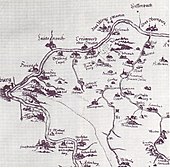Franciscan monastery Engelberg
| Engelberg Monastery | |
|---|---|
 The monastery church overall view with pilgrims' accommodations (2008) |
|
| location | Engelberg Monastery, Engelberg Monastery 1, 63920 Großheubach |
| Lies in the diocese | Diocese of Würzburg |
| Coordinates: | 49 ° 43 '26 " N , 9 ° 13' 55" E |
| Patronage | Archangel Michael and Mary Queen of Angels |
| founding year | In 1630 the construction of the monastery buildings began. The Capuchins looked after the pilgrimage and the monastery until secularization in 1823. In 1828 the convent was taken over by the Franciscans by order of King Ludwig I of Bavaria. |
| Year of dissolution / annulment |
1823 in the course of secularization in Bavaria. Only pilgrimages were banned. |
| Year of repopulation | 1828 as a Franciscan monastery |
The Franciscan monastery Engelberg is a Franciscan monastery near Großheubach in Lower Franconia ; Diocese of Würzburg . The well-known pilgrimage site is also the official burial place of the Princely House of Löwenstein-Wertheim-Rosenberg and is located on the striking Engelberg high above Großheubach, from where u. a. can be reached via 612 sandstone steps, the so-called "angel staggered".

history
The history of the Engelberg above the Main, then called "Rulesberg", goes back to the pre-Christian era. At that time there was a pagan place of worship , of which the so-called "Hünenstein" or "Heuneschüssel", a huge boulder with a bowl-like recess, still bears testimony.
Around 1300, a simple was on the mountain chapel of wood built and the Archangel Michael consecrated. As the leader of the heavenly host, he was chosen with preference as the patron saint of places in former pagan shrines. The old “Rulesberg” gradually became the “Engelberg”. At the beginning of the 14th century (1310 is mentioned) a statue of the Virgin Mary came into the chapel , which is venerated there as a miraculous image of grace and is the goal of pilgrimages.
The double veneration of the Archangel Michael and the Blessed Mother Mary, as "Queen of Angels", is the origin of the local pilgrimage. Your oldest authentic document, the content of which suggests a heavily visited but in need of repair chapel, dates from 1406.
As the number of pilgrims grew, the Archbishop of Mainz, Anselm Casimir Wambolt von Umstadt , to whose district the area belonged at the time , summoned the Capuchins to Engelberg in 1630 and had a monastery built for them. General Jakob Alfons Franz Calderon d'Avila donated the first documented altar of grace to Mary in 1692 , who was also buried in the monastery church in 1695 and whose grave slab is preserved there.
1828 was the Convention on the orders of King Ludwig I of Bavaria by the Franciscans of the Bavarian Franciscan Province adopted.
In 1865, in volume 1 of the “Pictures from the History of the Church”, the story “Maria Regina” by Countess Ida Hahn-Hahn appeared , which revolves around Engelberg Abbey above the Main.
Modern times
The provincial chapter of the German Franciscan Province , to which the convent has belonged since 2010, decided in March 2019 to give up the monastery in Engelberg as well as six other branches in the course of the concentration of the forces of the order province.
Engelberg Abbey above the Main is a permanent destination for numerous pilgrims and tourists. It is u. a. also known for its dark beer from wooden barrels, which is served in the monastery tavern.
Tomb of the princes of Löwenstein-Wertheim-Rosenberg
Since 1724 Engelberg Monastery has been the burial place of the Wittelsbach side line of the princes of Löwenstein-Wertheim-Rosenberg , who have resided at Löwenstein Castle in nearby Kleinheubach since 1721 , in which there is also a castle chapel, which was previously overseen by the Capuchins of Engelberg Monastery. The dead were originally buried in the Engelberg monastery church; In 1840 the princes had a separate crypt chapel built for their families on the monastery site, which is still used today as a family burial place. In the monastery church itself is the epitaph of Prince Ludwig Carl Franz Leopold zu Hohenlohe-Waldenburg-Bartenstein , a relative of the Löwenstein family, who had a carriage accident in 1799 and died in Kleinheubach.
Gallery royal crypt
Grave of Prince Karl Heinrich zu Löwenstein-Wertheim-Rosenberg
Epitaph Princess Adelheid zu Isenburg-Birstein , 1st wife of Prince Karl Heinrich
Epitaph Princess Sophie geb. von und zu Liechtenstein , 2nd wife of Prince Karl Heinrich
Grave of Agnes b. zu Hohenlohe-Langenburg (1804–1835), wife of Hereditary Prince Konstantin zu Löwenstein-Wertheim-Rosenberg
literature
- Nobert Vad: "Franciscan monastery and pilgrimage church Engelberg above the Main" , Schnell and Steiner, 2006, ISBN 3-7954-6601-6
- Philipp J. Madler: “The monastery on Engelberg; historically, topographically described " , Amorbach, 1843 ( digitized version )
- Philipp J. Madler: "The monastery on Engelberg and the family crypt of the dynasty Löwenstein-Wertheim-Rosenberg" , Weiden, 1857 ( digitized )
Web links
- Franciscan monastery Engelberg , basic data in the database Monasteries in Bavaria in the House of Bavarian History
- Website of the Franciscan monastery Engelberg
Individual evidence
- ↑ Illustrated page on the burial place of the princes of Löwenstein-Wertheim-Rosenberg ( memento of the original from April 19, 2014 in the Internet Archive ) Info: The archive link was inserted automatically and has not yet been checked. Please check the original and archive link according to the instructions and then remove this notice.
- ↑ Official page on the history of the monastery
- ^ Wallfahrtskirche Engelberg ob dem Main , p. 14, Volume 1210 by Schnell Art Guide , Schnell and Steiner Verlag, Regensburg, 1980
- ↑ Digital copies of both volumes of the short story "Maria Regina"
- ↑ franziskaner.net: Provincial Chapter 2019, March 22, 2019.
- ↑ Philipp Madler: The monastery on Engelberg and the family crypt of the dynasty Löwenstein-Wertheim-Rosenberg , Weiden, 1857; (Digital scan)











